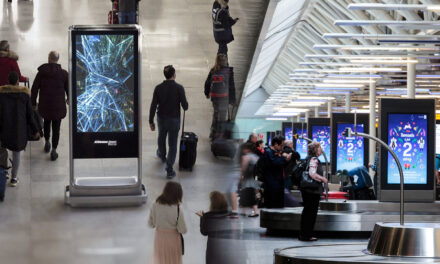The digital media quality in APAC trends indicate a user shift away from web experiences into apps as consumers adapted to stay-at-home behaviours and social restrictions during the COVID-19 pandemic, says Rob Kay, Senior Director Customer Success, IAS, APAC, in this interview with MartechAsia.
Recently, Integral Ad Science (IAS), a global leader in digital media quality, released its Media Quality Report (MQR) for H1 2021, providing transparency into the performance and quality of APAC digital media, alongside global comparisons. The latest MQR highlights brand safety, ad fraud, and viewability trends across display, video, mobile web, and in-app advertising.
We caught up with Rob Kay, Senior Director Customer Success, IAS, APAC, to understand the implications of the report’s major findings for brands and marketers.

What are the top highlights of the MQR report recently released by your company?
The recent MQR looked at several key highlights. In terms of brand risk, we saw widespread brand risk reductions for desktop display and mobile web display worldwide as consumer behaviors shifted during the COVID-19 pandemic and brands optimized ad placements toward contextually-relevant content. Nearly all APAC markets registered lower brand risk than the worldwide rate of 2.4% for desktop and 2.6% for mobile web display. Vietnam proved the safest market for brands running display ads on desktop mobile web, each at 0.6% brand risk. Indonesia remained the riskiest market for display ads, with brand risk reaching 4.7% on desktop and 4.5% on mobile web. Improvements in brand safety were generally driven by reductions in violent content, but offset by increases in adult content in some cases.
For our partners, this means increased efforts to optimise display ad placements toward contextually-relevant content led to lower brand risk in APAC. Global trends also show greater brand risk around video ads. Advertisers in APAC may benefit from applying their increased understanding of brand risk categories impacting display ad placements to their video campaigns.
As for ad fraud in desktop display, most APAC markets hovered close to or below the 1.0% global ad fraud average. Japan and Singapore remained the outliers with optimised against ad fraud rates up to 3x the worldwide benchmark. In the context of mobile web display, minimal but generalized reduction in ad fraud rates were seen across most APAC markets. Japan improved most, with a 0.4 percentage point (pp) annual reduction to bring the ad fraud rate down to 2.3% in H1 2021. Still, Japan remained the market most vulnerable to ad fraud in this environment across the world.
Ad fraud for display campaigns is well under control across APAC, with Japan and Singapore the only markets where optimisation against ad fraud remained a major opportunity. Global trends show a greater increase in ad fraud on video as video streaming uptake rose during the pandemic. While video benchmarks aren’t broadly available in APAC, advertisers are well advised to redouble efforts to protect video campaigns against fraud.
In terms of viewability, desktop display and mobile web display viewability trended lower, with the exception of Indonesia where viewability increased in both environments. Viewability rose marginally for mobile web in India. By contrast, all markets experienced higher viewability in mobile app display. Across all environments, most APAC markets registered lower viewability levels compared to worldwide averages. As for time-in-view in display, the metric trended lower in markets where annual comparisons were available, a likely result of lower viewability levels. Australia, Indonesia and Vietnam stood above the worldwide average in both desktop and mobile web.
These trends may indicate a user shift away from web experiences into apps as consumers adapted to stay-at-home behaviours and social restrictions during the COVID-19 pandemic. Further viewability gains remain an opportunity in display formats across APAC.
What are the key takeaways of the report especially for APAC marketers to take note of, in terms of Martech?
Metrics like viewability have come a long way over the last few years in APAC. Historically, low viewability markets have turned a corner and are much higher now as the industry takes this seriously. From a martech perspective, it’s time we start thinking about changing the attribution systems and start focusing more on quality media metrics. For instance, looking at only counting viewable impressions or removing fraudulent impressions in the attribution model. This includes removing traffic generated from fraudulent impressions from analytics platforms. In terms of personalisation of messaging, it is ensuring we’re thinking of metrics like time-in-view or viewability to make sure that the storytelling we’re using to reach users across platforms are more accurate.
What explains the high fraud rates in Singapore for desktop display? How does it compare with, say, such rates in Japan? How does it affect brands?
Privacy laws have reduced the effectiveness of cookies. and illegal bot operators are finding it increasingly difficult to retarget in Europe, shifting their focus to other lucrative APAC markets such as Australia, Singapore and Japan. These markets are definitely what we’d call high CPM markets across APAC and where the money goes, fraudsters are not far behind. In a market like Singapore, where the CPM is high but also the programmatic ecosystem is relatively well developed, there is much more complexity from an ad delivery perspective – it creates the perfect storm for fraudsters to defraud advertisers.
In Japan, we see a lot of advertising still focused on traditional metrics like CPC. Focusing on clicks and traffic typically position the market as an easy target for fraudsters. This is given how open and easy botnet technology is to obtain or the ease to buy fraudulent traffic. However, as third-party ad server penetration grows, which means more advertisers can now actively block fraud, it is expected that a reduction of Japan’s fraud rates can be seen in the next six to 12 months.
Now, as we head into Q4, advertisers must stay vigilant as fraudsters typically chase increased ad spend during the lucrative holiday shopping period.
Advertisers must maintain an all-encompassing approach to media quality, utilising insights to optimise campaign performance, and in preparing for a happy festive season.
They should work with trusted third-party verification companies to help protect their campaigns from ad fraud, brand risks, and lower viewability, and maximise engagement and ROI.
Why are India, New Zealand and Vietnam top brand safe markets? What does it mean for marketers and publishers? What are these markets doing that others are not?
Widespread brand risk reductions occurred worldwide as consumer behaviours shifted in the midst of the COVID-19 pandemic and brands optimized ad placements toward contextually-relevant content. Nearly all APAC markets registered lower brand risk than the worldwide rate of 2.4% for desktop and 2.6% for mobile web. Improvements in brand safety were generally driven by reductions in violent content, but offset by increases in adult content in some cases.
While this is so, the industry can’t become complacent – brand suitability is always evolving for marketers, and this requires constant vigilance to deliver precision for individual suitability thresholds. With cookies deprecating, to reach consumers at the right time, place and messaging, additional focus by marketers are needed to ensure good context control strategies especially with the holiday season approaching soon.
How do you see the video marketing trends in the region? Is Convergence emerging as a big opportunity?
The amount of video content on the internet is exploding given the ease of accessibility. Just about everyone one has:
- Access to a high quality camera in their pocket
- Access to the internet to upload videos on any number of purpose designed platforms that also makes it easy (i.e. YouTube/Facebook/TikTok)
Convergence has always been a big opportunity in the digital age – as stated earlier – though, markets need to start thinking about real quality metrics like viewability and time-in-view to really help gauge the true impact of their digital marketing efforts. Even if you run sophisticated personalised messaging campaigns with consistent messaging across multiple platforms, it will not matter if no one is on the other end of the device watching or scrolling past your video within 0.1 second.



















